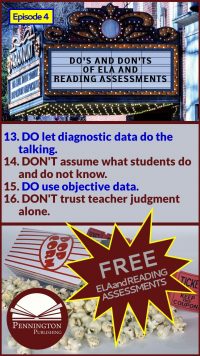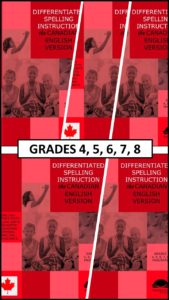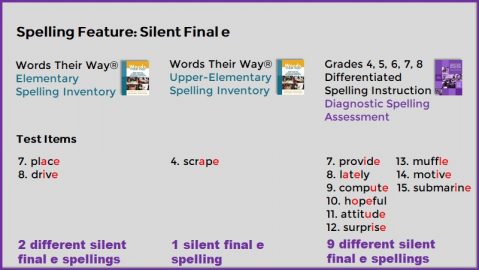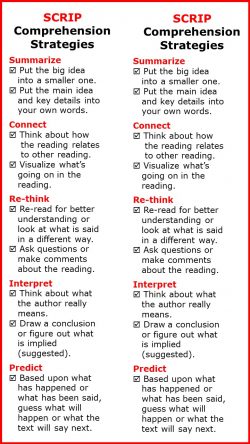
Assessment Do’s and Don’ts
Should you depend upon diagnostic ELA and reading data? I’ve been using a silly movie theme to weave together a series of articles for my Do’s and Don’ts of ELA and Reading Assessments series. So far I’ve offered these suggestions over the trailer and first three episodes:
-
- Episode 1
- Do use comprehensive assessments, not random samples.
- DON’T assess to assess. Assessment is not the end goal.
- DO use diagnostic assessments.
- DON’T assess what you won’t teach.”
-
- Episode 2
- DO analyze data with others (drop your defenses).
- DON’T assess what you can’t teach.
- DO steal from others.
- DON’T assess what you must confess (data is dangerous).
-
- Episode 3
- DO analyze data both data deficits and mastery.
- DON’T assess what you haven’t taught.
- DO use instructional resources with embedded assessments.
- DON’T use instructional resources which don’t teach to data.
Permit me to tell a brief anecdote. As a junior in high school, I got my license on my sixteenth birthday. At last, I could take my girlfriend out on a real date! Where to go? The movies, of course. Just one problem.
Friday night was guys’ night. My group of buddies and I always got together on Friday night. When Richard called me up after school to tell me that he would pick me up at 7:00, I quickly lied and told him that I was sick. Of course, I had already called my girlfriend to ask her to go to the movies.
We were munching on popcorn, half-way through the movie, when an obnoxiously loud group of guys entered the theater. Yes… my friends. I slumped down in my seat and told my girlfriend that I needed to see all the credits before leaving. When I assumed my friends had left the theater for their next Friday night adventure, my girlfriend and I slowly made our way up to the lobby.
Richard was the first friend to greet me. Let’s just say I paid dearly for that lie.
This article’s focus?
DO let diagnostic data do the talking. DON’T assume what students do and do not know. DO use objective data. DON’T trust teacher judgment alone.
The FREE assessment download at the end of this article includes a recording matrix and two great lessons… all to convince you to check out my assessment-based ELA and reading program resources at Pennington Publishing.
DO let diagnostic data do the talking.
One of the first lessons new teachers learn is how to answer this student or parent question: “Why did you give me (him or her) a ___ on this essay, test, project, etc.?”
Of course, every veteran teacher knows the proper response (with italics for speech emphasis): “I didn’t give you (him or her) anything. You (he or she) earned it.
A less snotty and more effective response is to reference the data. Data is objective. Changing the subjective nature of the question into an objective answer is a good teacher self-defense mechanism and gets to the heart of the issue.
Diagnostic data is especially helpful in answering why students are having difficulties in a class. Additionally, the data in and of itself offers a prescription for treatment. Going home from the doctor with a “This should go away by itself in a few weeks” or a “Just not sure what the problem is, but it doesn’t seem too serious” is frustrating. Patients want a prescription to fix the issue. Parents and students can get that prescription with assessment-based instructional resources.
One other application for both new and veteran teachers to note: A teacher approaches her principal with this request: “I need $$$$ to purchase Pennington Publishing’s Grammar, Mechanics, Spelling, and Vocabulary BUNDLE. Our program adoption does not provide the resources I need to teach the CCSS standards.”
Answer: “Not at this time.”
Instead, let diagnostic data do the talking.
“Look at the diagnostic data on this matrix for my students. They need the resources to teach to these deficits.”
Answer: “Yes (or Maybe)”
DON’T assume what students do and do not know.
We teachers are certainly not free of presuppositions and bias. As a result, we assume what has yet to be proven. In other words, we beg the question regarding what our students know and don’t know.
He must be smart, but just lazy. His older sister was one of my best students. They’re in an honors class; of course they know their parts of speech. I have to teach everything as if none of my students knows anything; I assume they are all tabula rasa (blank slates). You all had Ms. Peters last year, so we don’t have to teach you the structure of an argumentative essay.
Effective diagnostic assessments eliminates the assumptions. Regarding diagnostic assessments, I always advise teachers: “If they know it, they can show it; if they don’t, they won’t.”
DO use objective data.
Not all diagnostic assessments are created equally. By design, a random sample assessment is subjective, no matter the form of sampling. Those of you who remember your college statistics class will agree.
Teachers need objective data, not data which suggests problem areas. Teachers need to know the specifics to be able to inform their instruction. For this application, objective means comprehensive.
The “objective” PAARC, SWBAC, or state-constructed CCSS tests may indicate relative student weaknesses in mechanics; however, teachers want to know exactly which comma rules have and have not been mastered. Teachers need that form of objective data.
DON’T trust teacher judgment alone.
After years of teaching, veteran teachers learn to rely on their judgment (as they should). After a few more years of teaching, good teachers learn to distrust their own judgment at points. Experienced teachers look for the counter-intuitive in these complex subjects of study that we call students. What makes them tick? Kids keep our business interesting.
Diagnostic and formative assessments bring out our own errors in judgment and help us experiment to find solutions for what our students need to succeed. Assessments point out discrepancies and point to alternative means of instruction.
For example, a student may score high in reading comprehension on an un-timed standards-based assessment. Also, she was in Ms. McGuire’s highest reading group last year. Most teachers would assume that she has no reading problems and should be assigned to an advanced literacy group.
Yet, her diagnostic spelling assessment demonstrates plenty of gaps in spelling patterns. A wise teacher would suspend her initial judgment and do a bit more digging. If that teacher gave the Vowel Sounds Phonics Assessment (our FREE download at the end of this article), the student might demonstrate some relative weaknesses. She may be an excellent sight-word reader, who does fine with stories, but one whom will fall apart reading an expository article or her science textbook.
Like my dad always told me… Measure twice and cut once.
Thanks for watching Episode 4. Make sure to buy your ticket for the next installment of ELA and Reading Assessments Do’s and Don’ts: Episode 5 before you sneak out of the theater with your girlfriend or boyfriend. Also get more 15 FREE ELA and reading assessments, corresponding recording matrices, administrative audio files, and ready-to-teach lessons. A 94% score on Rotten Tomatoes! Here’s the preview: DO treat assessment as instruction. DON’T trust all assessment results. DO make students and parents your assessment partners. Don’t go beyond the scope of your assessments.
*****

The Science of Reading Intervention Program
The Science of Reading Intervention Program: Word Recognition includes explicit, scripted instruction and practice with the 5 Daily Google Slide Activities every reading intervention student needs: 1. Phonemic Awareness and Morphology 2. Blending, Segmenting, and Spelling 3. Sounds and Spellings (including handwriting) 4. Heart Words Practice 5. Sam and Friends Phonics Books (decodables). Plus, digital and printable sound wall cards and speech articulation songs. Print versions are available for all activities. First Half of the Year Program (55 minutes-per-day, 18 weeks)
The Science of Reading Intervention Program: Language Comprehension resources are designed for students who have completed the word recognition program or have demonstrated basic mastery of the alphabetic code and can read with some degree of fluency. The program features the 5 Weekly Language Comprehension Activities: 1. Background Knowledge Mentor Texts 2. Academic Language, Greek and Latin Morphology, Figures of Speech, Connotations, Multiple Meaning Words 3. Syntax in Reading 4. Reading Comprehension Strategies 5. Literacy Knowledge (Narrative and Expository). Second Half of the Year Program (30 minutes-per-day, 18 weeks)
The Science of Reading Intervention Program: Assessment-based Instruction provides diagnostically-based “second chance” instructional resources. The program includes 13 comprehensive assessments and matching instructional resources to fill in the yet-to-be-mastered gaps in phonemic awareness, alphabetic awareness, phonics, fluency (with YouTube modeled readings), Heart Words and Phonics Games, spelling patterns, grammar, usage, and mechanics, syllabication and morphology, executive function shills. Second Half of the Year Program (25 minutes-per-day, 18 weeks)
The Science of Reading Intervention Program BUNDLE includes all 3 program components for the comprehensive, state-of-the-art (and science) grades 4-adult full-year program. Scripted, easy-to-teach, no prep, no need for time-consuming (albeit valuable) LETRS training or O-G certification… Learn as you teach and get results NOW for your students. Print to speech with plenty of speech to print instructional components.
I’m Mark Pennington, ELA teacher and reading specialist. Check out my assessment-based ELA and reading intervention resources at Pennington Publishing.
Get the Vowel Sounds Phonics Assessment with Audio File and Matrix FREE Resource:

Grammar/Mechanics, Literacy Centers, Reading, Spelling/Vocabulary, Writing
assessment for learning, assessment-based instruction assessment, Common Core grammar alignment document, diagnostic reading assessments, diagnostic reading tests, diagnostic spelling assessment, ELA diagnostic assessments, free diagnostic assessments, free reading assessments, LA diagnostic tests, Mark Pennington, quick diagnostic assessments, reading assessments, reading tests, spelling assessment, Teaching Reading Strategies, Universal Design for Learning, vowel sounds phonics assessment



 Yes, these assessments are free: Phonemic Awareness, Vowel Sounds Phonics, Consonant Sound Phonics, Heart Words, Rimes, Spelling, Fluency. All but the fluency assessment are designed for whole class administration for students ages 8-adult.
Yes, these assessments are free: Phonemic Awareness, Vowel Sounds Phonics, Consonant Sound Phonics, Heart Words, Rimes, Spelling, Fluency. All but the fluency assessment are designed for whole class administration for students ages 8-adult. 










